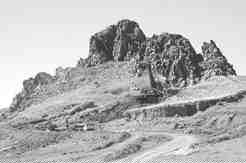The Esquel gold project in southern Argentina has enough reserves to sustain a proposed 5,000-tonne-per-day open-pit mine for 6.5 years, and London-based
Brancote is the operator and 74% owner of project, which is estimated to contain 3.8 million oz. Esquel is centred on a near-surface, low-sulphidation, epithermal high-grade vein system that extends over 2.4 km. The remaining interest is held by a private group of Argentine investors.
The project comprises 433 sq. km in Chubut province, close to the Chilean border in the foothills of the Patagonia region, and is 10 km north of the provincial town of Esquel (population 30,000) at an elevation of 1,200-1,400 metres. The core area is at the southern end of Cordon Esquel and measures 3.5 km north-south and 1.5 km east-west. The massive vein system containing Galadriel, Galadriel Sur, Football Field, Julia and Elena Norte cuts diagonally across the core area in a northeast direction.
At the end of a fourth round of drilling, completed in June, engineering consultant Pincock, Allen & Holt (PAH) estimated a measured, indicated and inferred resource totalling 19.3 million tonnes grading 6.06 grams gold and 11.1 grams silver per tonne. This is equivalent to 3.8 million contained ounces gold and 6.9 million contained ounces silver, based on a cutoff grade of 1 gram gold.
PAH recently completed a prefeasibility study that envisions an open-pit mine and conventional processing plant designed to treat 5,000 tonnes of ore per day (or 1.8 million tonnes per year) using conventional gravity concentration and the carbon-in-leach (CIL) method. Accordingly, 500,000 oz. gold per year would be produced.
Proven and probable open-pit reserves are estimated to contain 2.8 million oz. gold and 4.8 million oz. silver in 10.4 million tonnes grading 8.46 grams gold and 14.57 grams silver, or a diluted 11.5 million tonnes grading 7.59 grams gold and 13.06 grams silver, using a dilution factor of 11.5% and zero grade. The estimates are based on an overall waste-to-ore stripping ratio of 11.2:1 (9.9:1 diluted) in three pits.
The prefeasibility study proposed transporting the crushed material from the open pits via a 2.5-km-long enclosed conveyor over an elevation drop of 450 metres to the plant, as opposed to trucking it. The conveyor will ultimately provide savings in mine costs and is considered to be environmentally safer. An owner-operated mining fleet has been selected over contract mining.
Life-of-mine cash costs are forecast to average US$102 per oz., plus an extra US$9 per oz. for royalty and refining charges. Capital costs are pegged at US$131 million, plus or minus 25%, including US$41.2 million for indirect charges and contingencies.
Brancote resumed exploration and infill drilling on the project at the beginning of October. The company will define and upgrade some 494,000 oz. gold that are in an inferred resource of 4.7 million tonnes grading 3.27 grams gold and 6.9 grams silver. In addition, a further six vein systems near existing resources have been targeted for follow-up drilling.
Brancote trades on the London Stock Exchange at 1.36 in a 52-week range of 2.35-1.11. The company recently placed 1 million shares at 1.22 each through Seymour Pierce to raise funds for continued exploration at Esquel.


Be the first to comment on "Esquel looking good for Brancote"